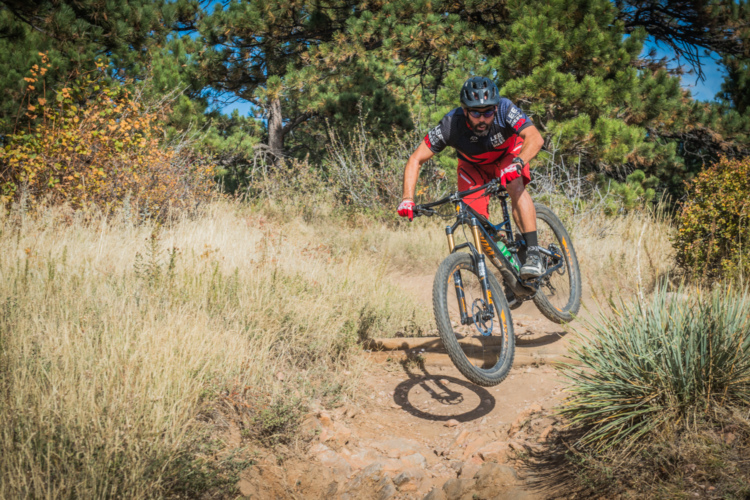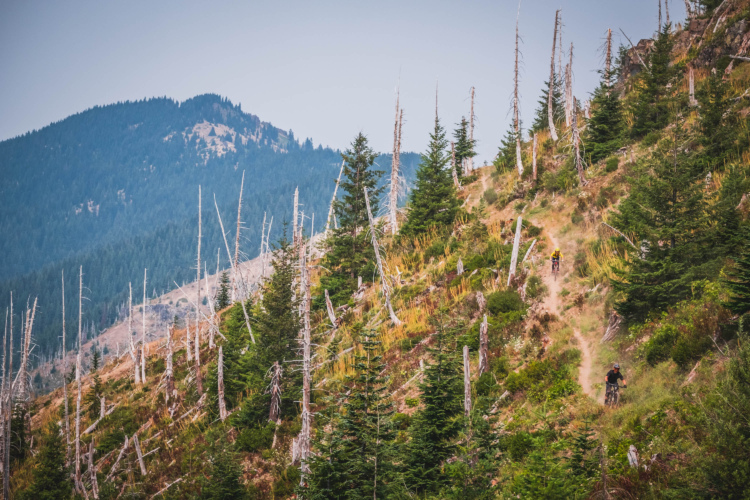In my humble opinion, one of the coolest things about the Singletracks database is the ability to flesh out the amount of information about a specific trail or trail system as much as you could possibly want. Being something of a statistics geek myself, I love cataloging singletrack and adding trail information!

One of the most useful features in the database is the ability to link trails together that form a complex trail system. The Bull / Jake Mountain Trail System is a great example of this approach. This trail system is a largely self-contained network of trails that form one cohesive whole, but some of the individual trails in the trail system are radically different from others, with different technical difficulties and different amounts of elevation gain.
The best way to show the differences between these individual sub-trails is to create a trail system listing.
First, do a few searches in our mountain bike trails database to ensure that the trail system isn’t already listed. If it isn’t, then it’s time to add it! Here’s how to create a trail system listing:
1. Add a new trail listing with information for the overall trail system.
Use the add new trail form, and when you write the trail description, include mileage and information for the entire trail complex–not just one trail within it. In this example, I’m creating a trail system for Steamboat Ski Resort.
Sometimes, we’ll have a listing for the overall trail system already in the database here on Singletracks, but we might not have information about all of the many sub-trails within that trail system. If that’s the case, just skip step #1 and continue on to step #2.
2. Add general information for the trail system.
Submit the GPS location of the trail system trailhead, your review of the overall trail system, general photos, a complete GPS map of the entire trail system, etc. If you have photos from specific trails, hold off on uploading those for the moment.
3. Add trail listings for the individual trails in the trail system.
Now, this is where the magic happens! Using the same add new trail form, submit separate listings for each of the trails within the trail system. BUT, when you add each trail, start typing the name of the overall trail system (the listing that you just added above) into the “Parent Trail System” blank. The form should attempt to autocomplete, and a drop down list of options will appear. Select the correct trail from the list (in this case, “Steamboat Ski Resort”) and continue filling in the rest of the trail information.
Now, when you click the “Submit” button at the bottom of the page, this trail will automatically be added as a sub-trail of the trail system!
4. Review each sub-trail.
Once you’ve added trail listings for all the sub-trails, it’s time to review each trail (or at least, the trails you’ve ridden). One of the coolest things about the trail system pages is the ability to see which trails in the system are difficult and which are easy, and to tailor your ride accordingly. To get the little difficulty ratings next to each trail, the trails need to be reviewed. When you add the review, be sure to give it a difficulty rating!
If you have reviewed the sub-trails and made sure to click one of the bubbles for the difficulty ratings but you don’t see the difficulty rating displayed on the page immediately, fear not. It takes a little while for the ratings to propagate throughout the website, but they’ll show up eventually.
5. Add photos to the sub-trails.
Since all of the sub trails have been tagged as a part of the trail system, you can now upload photos to each individual trail listing. Photos from all of the sub-trails will automatically be included in the larger trail system gallery.
6. Add more information, if you choose.
As I mentioned above, you can continue to flesh out the trail system listing to your heart’s content. You can add videos to each of the sub-trails, GPS tracks of recommended routes to the main trail system listing, and/or GPS tracks of the individual sub-trails to the sub-trail listings… and much, much more!
So what are you waiting for? Do a search to see if your favorite trail system is in the Singletracks database, and if it isn’t, be sure to add it!





























7 Comments
Aug 25, 2013
Aug 25, 2013
Aug 27, 2013
It doesn't seem to make sense to have Blue Sky and Coyote Ridge fall under a single trail system, partly because the trail access is so different for the vast majority of riders. Then you'd probably need to suck in the Devil's Backbone and HTMP systems, which would then beg questions about the Lory State Park trail system, and the dominoes get ugly.
Hence, it seems to make sense to have Rimrock as a subtrail for both major trails.
Aug 27, 2013
So, one issue of trail categorization that I've wrestled with for a long time, are national forests with very complex, expansive trail networks. Sure, there are some trail systems like Buffalo Creek and Bull Mountain that are systems within the forests, but other forests have interconnected trails that span for hundreds of miles. It would be counter productive to make a trail listing for a system that big.
So consequently, in areas such as Pisgah National Forest with hundreds of miles of trails, I've taken to adding individual listings for each individual named trail. This creates a lot of listings, but the different listings can be useful, but the trick is to see how the trails fit together.
This is where our new recommended rides feature comes in to play. Now, with the new recommended rides GPS tracks, you can include other trails in the area in the ride, so other people can see how the whole puzzle fits together.
So to answer your question, I'm almost more inclined to not list Rimrock as connected with EITHER of those trail systems, and just let the recommended rides include the rimrock trails and other surrounding trails.
What do you think?
Aug 27, 2013
Aug 27, 2013
Aug 27, 2013
However, like you said, when it comes down to a couple hundred yard-long section of trail, things start to get ridiculous... so you can be judicious, if you'd like. But in general, we follow the lead of the official map.